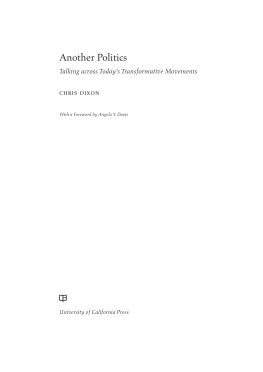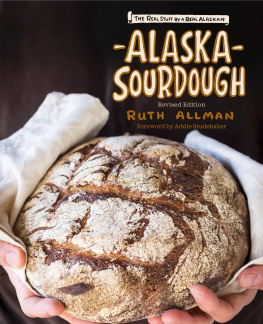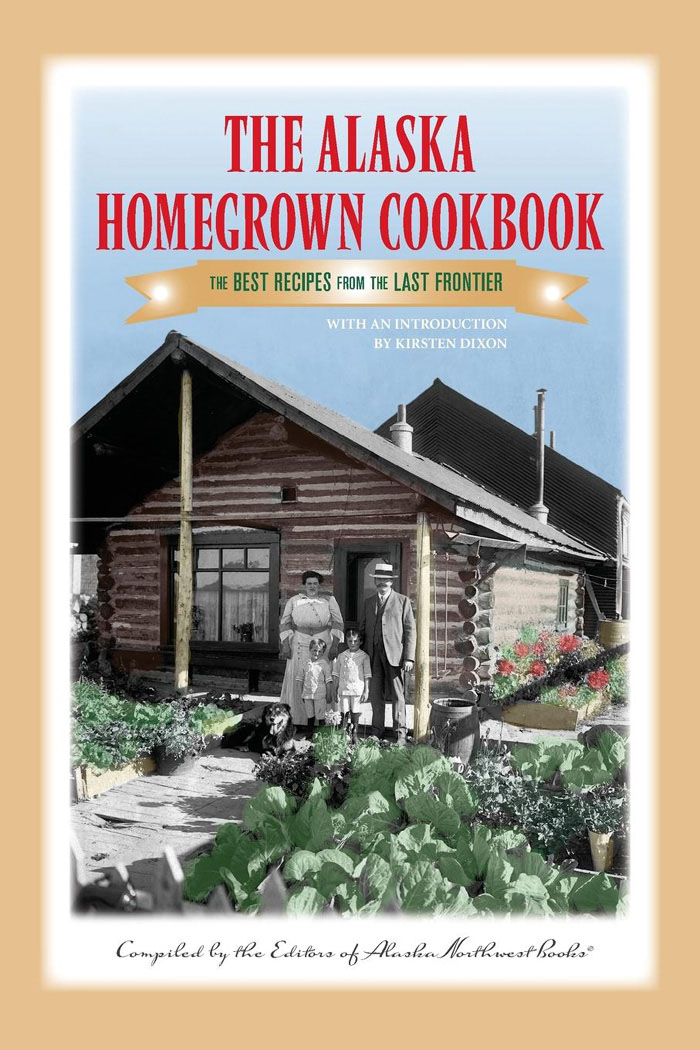THE ALASKA
HOMEGROWN COOKBOOK

WITH AN INTRODUCTION BY KIRSTEN DIXON

T HE L OUIS S PLITZ F AMILY IN FRONT OF THEIR HOME IN R UBY

DISCLAIMERS The publisher has made a conscientious effort to contact all of the copyright holders of all copyrighted works from which this collection was compiled. Though the plants included in these recipes have been traditionally used as food, positive species identification in the field is the readers responsibility. If identity is questionable, do not gather or ingest a plant. Neither the recipes authors nor the publisher is responsible for allergic or adverse reactions individuals may experience from the wild foods (greens, mushrooms, game meat, etc.) included in this collection of recipes. Text 2007 by Alaska Northwest Books Copyright to archival photographs as credited on page 224. Illustrations 2007 by Mindy Dwyer Book compilation 2007 by Alaska Northwest Books An imprint of Graphic Arts Books P.O.
Box 56118 Portland, OR 97238-6118 (503)254-5591 www.graphicartsbooks.com All rights reserved. No part of this book may be reproduced or transmitted in any form or by any means, electronic or mechanical, including photocopying, recording, or any information storage or retrieval system, without written permission from the publisher. Library of Congress Cataloging-in-Publication Data: The Alaska homegrown cookbook: the best recipes from the last frontier. p. cm. Includes bibliographical references and index.
ISBN 978-0-88240-857-6 (softbound) 1. Cookery,American.2. CookeryAlaska. I.Alaska Northwest Books (Firm) TX715.A274 2007 641.5973dc22 2007022853 Editor: Ellen Wheat Designer: Elizabeth Watson Illustrator: Mindy Dwyer  Contents Preface W e at Alaska Northwest Books are happy to continue a tradition started in 1963, when founder and publisher Bob Henning published the companys first cookbook about Alaska foods, The Alaskan Camp Cook. He described that effort as a labor of love, not just for the pleasure of sharing great recipes but for sharing Alaska and its natural bounty. Since that first cookbook some 40 years ago, each cookbook we have released has been more than a collection of recipes: each reflects the rich flavor and cultural heritage of Alaska as well as the independent spirit and welcoming nature of all Alaskans.
Contents Preface W e at Alaska Northwest Books are happy to continue a tradition started in 1963, when founder and publisher Bob Henning published the companys first cookbook about Alaska foods, The Alaskan Camp Cook. He described that effort as a labor of love, not just for the pleasure of sharing great recipes but for sharing Alaska and its natural bounty. Since that first cookbook some 40 years ago, each cookbook we have released has been more than a collection of recipes: each reflects the rich flavor and cultural heritage of Alaska as well as the independent spirit and welcoming nature of all Alaskans.
People everywhere gather to share food. In Alaska, sharing meant survival for our earliest residents. Today, sharing food among Alaskas indigenous peoples is a means of cultural survival as well. Many early homesteaders in the Northland lived far from stores, so they hunted, fished, gathered wild plants, and grew what vegetables they could to supplement the staples of flour, sugar, and canned goods they ordered in bulk and stored. Life was slower then, and there always seemed to be time to sit down with a visitor to trade stories over a cup of coffee and a slice of pie or a bowl of hot, steaming stew. Sharing food in Alaska is still a cultural tradition.
Many Alaskans today live much closer to stores now, but far from family, so gathering with friends for a meal is a way to soften solitude and to brighten long winters. Sharing recipes is also a continuing tradition. Alaskans are eager to find a new way to cook a freezer full of salmon or wild berries, or to prepare the giant zucchini and cabbages we grow here over the long summer daylight hours. To create this collection of recipes, we pored over all of the cookbooks we have published since the beginning. Faced with thousands of recipes, it was no easy task to decide what to include. We focused on choosing foodsseafood, game, fruits, vegetables, baked treatsthat are distinctively Alaskan or have become longstanding Alaska favorites.
We picked a variety of recipes that have proven appeal to us and to others, including those that make our mouths water, those that are especially interesting from a historical or cultural perspective, and those that represent a modern fusion of Alaskan and international cuisines. We organized the book by type of food and/or by course. We retained the style and voice of each recipe from its original source to honor the author/editor and to reflect the character and times of that cookbook, so youll find quite a mix of recipe presentations. We have also gathered tidbits from the cookbooks and other books published by Alaska Northwest Books that address the culture of food in Alaska, and have sprinkled them throughout the pages of this book as sidebars. Those comments about food in the Northland from 40-plus years of publishing offer particular insights by Alaskans. We want to thank all the contributors and authors of the cookbooks for their willingness to let us present their recipes in this new collection.
Every attempt was made to contact each original contributor, but many of these cooks are no longer with us; we hope they will appreciate that a new audience is enjoying their recipes. At the back of the book, weve included a source list of all the cookbooks used to complete The Alaska Homegrown Cookbook. If you find a recipe you like from one, you may want to add that book to your collection. Compiling this book has been a trip down memory lane for me and for all of us involved. Some of the books predate my time with the company, but our editors and I helped conceive many of them and send them into the world, working closely with the authors who became like family to all of us. We are delighted to offer this new tribute to these great cooks and to continue the tradition of sharing good Alaskan food.
Sara Juday Associate Publisher Introduction KIRSTEN DIXON A lthough I live at a wilderness lodge in a roadless area of Alaska, I own a small house in Anchoragea kind of reverse cabin in the woods. This comfortable cottage offers refuge to civilization, a respite from rural Alaska lodge life so appreciated now and then a trip to the bookstore or dinner out to a favored ethnic restaurant. Its here that I keep the majority of my coveted cookbook collection. I own hundreds of cookbooks, all carefully catalogued, organized by category, frequently referred to, and dearly loved. I am often in Anchorage during freezeup and breakup, the times of year when airplanes cant fly in or out of our remote location. Its then that you can find me sitting cross-legged in front of a big pile of books, thumbing through pages, attaching small sticky tabs to mark where to find a particular recipe or passage or tip.
Of all of my books, my favorite collection is the shelf filled with Alaskan cookbooks. The majority of the sources used in this compilation are represented there. I can sit for hours, lost in the stories of the people who took the time to share their lives, their knowledge of living in Alaska, and the recipes that became important to them. These recipes arent merely instructions on how to prepare food. They are living, interactive stories of how Alaskans have managed to define themselves through their cuisine. Each recipe in this collection sheds a bit of light on who we are as a people.
What is Alaskan cuisine? At first blush, it might seem that Alaska is too far off any culinary roadmap to be able to define a specific culinary style. But take a closer look, and you will find that we have a unique and vibrant food culture that reflects our natural world, our social and cultural history, our geographic place on the earth, and our values of self-sufficiency and independence. Our Alaska native legacy is still reflected everywhere in daily life herein our artwork, our clothing, and our social life. Many native communities still hold on to a vibrant heritage of consuming indigenous foods such as walrus and seal. You might not have access to foods such as walrus, (and, of course, marine mammals are now protected outside of Native populations) but the inclusion of these traditional recipes in this collection provides the opportunity for authentic understanding and insight into Native culinary traditions. 











 WITH AN INTRODUCTION BY KIRSTEN DIXON
WITH AN INTRODUCTION BY KIRSTEN DIXON  T HE L OUIS S PLITZ F AMILY IN FRONT OF THEIR HOME IN R UBY
T HE L OUIS S PLITZ F AMILY IN FRONT OF THEIR HOME IN R UBY  DISCLAIMERS The publisher has made a conscientious effort to contact all of the copyright holders of all copyrighted works from which this collection was compiled. Though the plants included in these recipes have been traditionally used as food, positive species identification in the field is the readers responsibility. If identity is questionable, do not gather or ingest a plant. Neither the recipes authors nor the publisher is responsible for allergic or adverse reactions individuals may experience from the wild foods (greens, mushrooms, game meat, etc.) included in this collection of recipes. Text 2007 by Alaska Northwest Books Copyright to archival photographs as credited on page 224. Illustrations 2007 by Mindy Dwyer Book compilation 2007 by Alaska Northwest Books An imprint of Graphic Arts Books P.O.
DISCLAIMERS The publisher has made a conscientious effort to contact all of the copyright holders of all copyrighted works from which this collection was compiled. Though the plants included in these recipes have been traditionally used as food, positive species identification in the field is the readers responsibility. If identity is questionable, do not gather or ingest a plant. Neither the recipes authors nor the publisher is responsible for allergic or adverse reactions individuals may experience from the wild foods (greens, mushrooms, game meat, etc.) included in this collection of recipes. Text 2007 by Alaska Northwest Books Copyright to archival photographs as credited on page 224. Illustrations 2007 by Mindy Dwyer Book compilation 2007 by Alaska Northwest Books An imprint of Graphic Arts Books P.O.  Contents Preface W e at Alaska Northwest Books are happy to continue a tradition started in 1963, when founder and publisher Bob Henning published the companys first cookbook about Alaska foods, The Alaskan Camp Cook. He described that effort as a labor of love, not just for the pleasure of sharing great recipes but for sharing Alaska and its natural bounty. Since that first cookbook some 40 years ago, each cookbook we have released has been more than a collection of recipes: each reflects the rich flavor and cultural heritage of Alaska as well as the independent spirit and welcoming nature of all Alaskans.
Contents Preface W e at Alaska Northwest Books are happy to continue a tradition started in 1963, when founder and publisher Bob Henning published the companys first cookbook about Alaska foods, The Alaskan Camp Cook. He described that effort as a labor of love, not just for the pleasure of sharing great recipes but for sharing Alaska and its natural bounty. Since that first cookbook some 40 years ago, each cookbook we have released has been more than a collection of recipes: each reflects the rich flavor and cultural heritage of Alaska as well as the independent spirit and welcoming nature of all Alaskans.